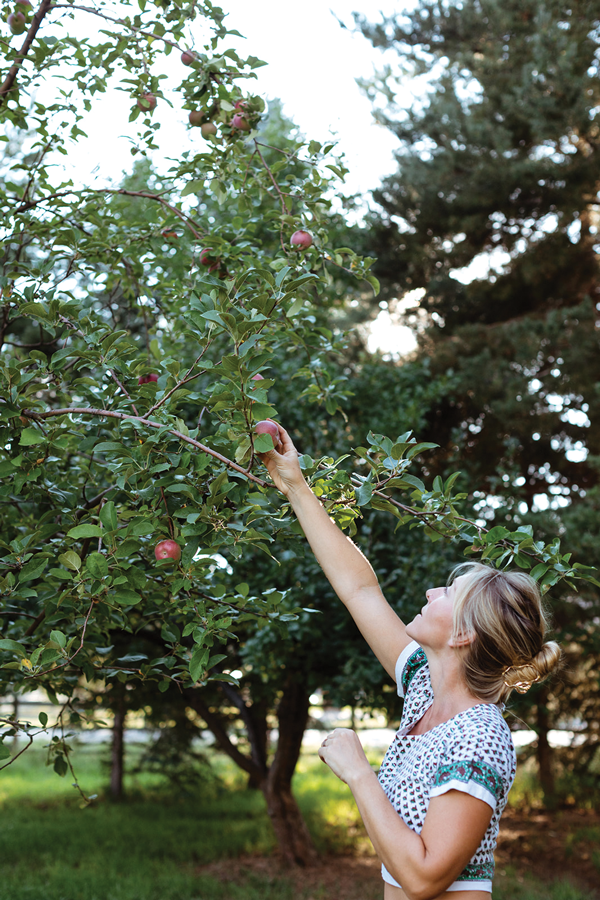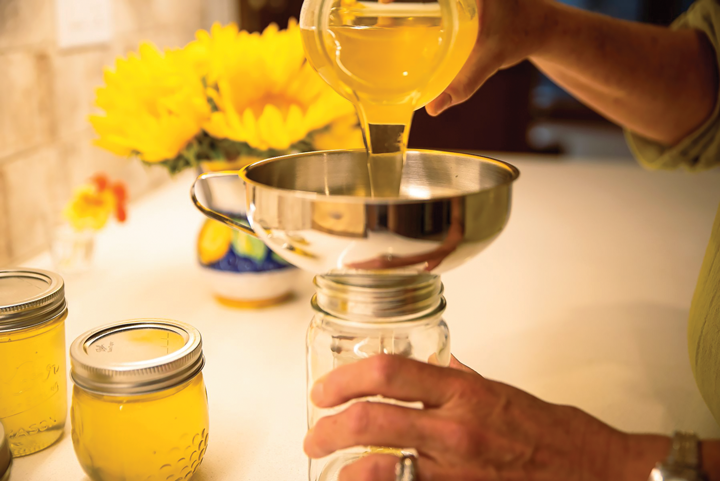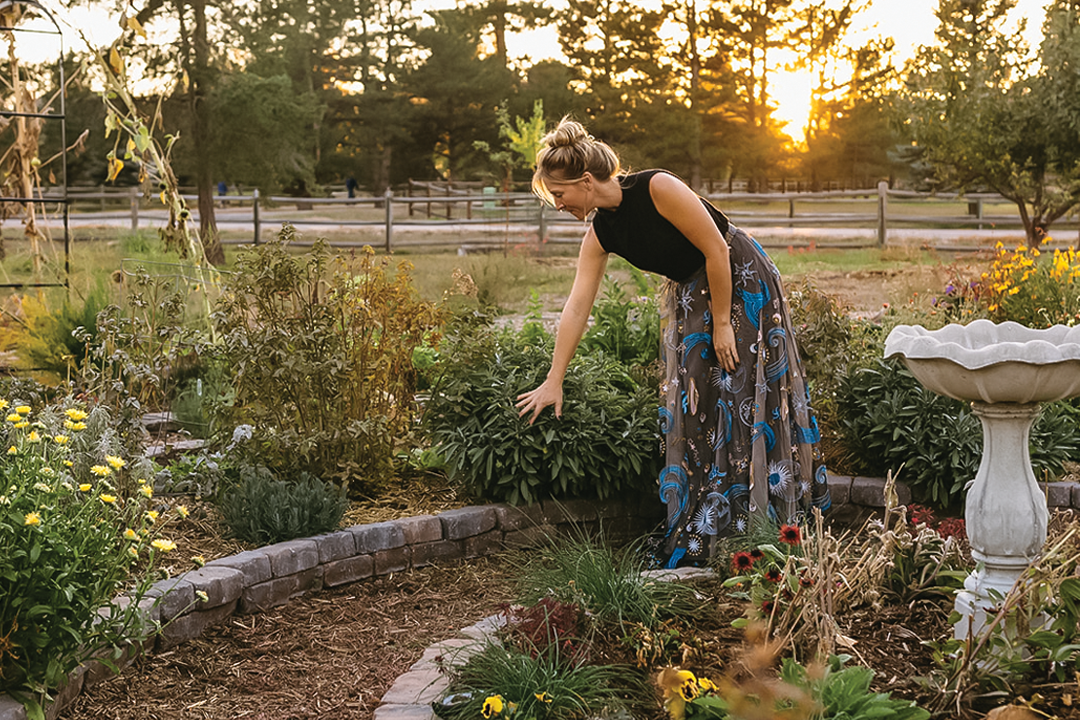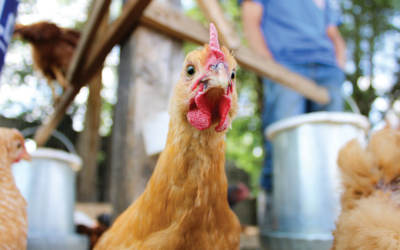Ten years ago, Realtor Jessica Jimenez and her husband bought a four-acre property in west Greeley. Their main motivation was to provide nutritious food for their family without using chemicals and pesticides. Now it’s a part-time job: Jimenez spends 20 hours a week caring for her suburban farm.
“Within the first year, we purchased a horse, then goats, then chickens. Now it’s a daily lifestyle,” she says. “Baby goats were born yesterday morning in the cold. I was breaking water troughs that were frozen [to give them water].”
She’s still happy to do it. The food alone makes it worth it.
“I taste the difference in the freshness: There’s a richer flavor in all the food, and the eggs have richer, darker yolks because I supplement the chickens’ grains with weeds, damaged fruit and excess vegetables,” she says.
For Jimenez, homesteading is a lifestyle that feeds the soul. Last year she planted fruit trees and grapevines so she could freeze the fruit and use it in the winter. And that’s just the beginning.
“I’m not a canning expert, but as harvests get bigger, that will be the next succession,” she says.
Many others who share Jimenez’s outlook on life despite residing in urban and suburban locales have adopted their own version of homesteading. The practice is deeply embedded in the American psyche and has been linked to periods of unrest, including after the American Civil War, and more recently, the COVID-19 pandemic.
Homesteading often involves growing fruits and vegetables, raising livestock, beekeeping, worm farming and making soap and other organic products. It can include many different things, as Jimenez shows, and one thing can lead to another.

Cortney Kern, of Mother Gardener, in her garden.
By Jules Kennedy Photography.
Another example is Lydia Tirpak, whose family lives in west Berthoud on a two-acre lot in a quiet, well-maintained neighborhood. Their property features 12 garden beds, a vineyard and an orchard with apple, cherry and peach trees. After caring for 16 chickens on another property—and having more eggs than she knew what to do with—she’s now spearheading an effort to petition her neighborhood homeowners association to allow chickens. Even as more residents like her express an interest in homesteading, many cities and HOAs still have strict rules about raising livestock.
“Chickens are the best composters: They’re omnivorous and hunt and eat mice better than some cats,” Tirpak says. “They’re big garbage disposals but also fluffy, mini velociraptors.”
Tirpak grew up in New York surrounded by her mom’s garden and fruit trees and never stopped homesteading. She says influencers like Martha Stewart (a known chicken lover) have made the concept trendy in urban settings.
“There’s something lovely about getting fruit from the tree—I don’t know if it harkens back to childhood or something deeper,” she says. “It’s rewarding and satisfying to produce food from dirt and seeds that you can enjoy later in the season.”
Little land, no problem
Even the smallest spaces can be designated for nurturing plants or livestock. Since 2007, Idy Craft, her husband and three daughters have surrendered their backyard to chickens, gardens and a rabbit hutch. The family lives on less than a quarter-acre lot in downtown Loveland.
Craft believes social media discourages many people from becoming homesteaders because they don’t have the perfect property.
“The urban homestead is a mindset,” she says. “It’s a desire to provide for yourself what you can in your circumstances, whether you grow lettuce and tomatoes on your apartment balcony or have 30 acres.”
After nearly a decade, Craft still finds the lifestyle exciting.
“These little birds bring me great joy,” she says of her family’s combined 10 ducks and chickens, all of which have names. “For my kids, having something other than themselves to look after and nurture—and having a front-row seat to see where the food we eat comes from—is such a valuable lesson.”

Lisa Boesen pouring honey. Photo by Travis Nickey.
Driven by health needs
Craft was diagnosed with celiac disease in 2003 and lupus a year later. Those diagnoses made her take a hard look at the food system, what she was consuming and what foods cause inflammation. Her naturopathic doctor encouraged her to follow an organic diet to remove pesticides and chemicals.
Her childhood was a source of inspiration: She grew up watching her mom and best friend make everything from scratch, including jams, jellies and pickles. She even helped her mom tend the community gardens at Greeley’s Houston Gardens.
“My childhood was full of cooking,” she says. “Dad went through a period of making bread, too.”
Craft makes her own soup stock, spaghetti sauce and bread. Along with growing herbs and vegetables and foraging in public places for edible plants where it’s permitted (she knows where there are apple trees on a roadside that never get picked), she makes cider, wine and apple cider vinegar. She also makes homemade cleaning and body products from lard or whipped tallow. These life changes have improved her health.
“I don’t know where I would be if I hadn’t taken this path,” she says.
Homesteading has allowed Rachel Dirks, a yoga and reiki practitioner, to realign her life with nature after experiencing three pulmonary embolisms. She and her husband bought 40 acres in Bellvue three years ago, built a home and moved their family from the Johnstown area last year.
For Dirks, realignment means “having a deep connection to what you’re putting in and on your body and knowing where things are coming from.” She believes that you are what you eat and what you wear or put on your skin.
In addition to hunting, fishing and foraging off her land, Dirks makes candles, an antibiotic herb oil, natural cleaning supplies and ginger ale from pine needles.
“I want to teach my kids how to care for their bodies and identify different plants,” she says. “It’s how to take care of themselves instead of identifying brands of clothing.”
Keeping bees healthy and happy
Bees are popular with urban homesteaders, but it’s still animal management, says Lisa Boesen, who became a beekeeper by accident when she stepped in to help a friend.
“Getting started isn’t like Better Homes & Gardens where you’re thinking, ‘Let’s put them in the backyard and they’ll take care of themselves,’” she cautions. “Don’t do it to save the bees. Become a beekeeper because you want to make honey.”
Boesen recommends getting a mentor and joining one of the many local bee clubs, like the Northern Colorado Beekeepers Association, which she is a past president of. Understanding that bee husbandry has a three-to-five-year learning curve is a requirement, she says.
“You’re a meteorologist, a farmer, a doctor, a scientist,” she says. “There are 50,000 little live beings relying on you to work with them to be functional.”
Learn from the experts
As the director of the Colorado Permaculture Guild, Christy Grace transforms her passion for regenerative gardening and worm farming into a community resource. She hosts workshops, events, retreats and more on her three-quarters of an acre just north of Fort Collins. She also hosts permaculture teacher training weekends each spring.
Along with providing gardening tips, Grace teaches about food preservation systems, including how to can and dehydrate fruits and vegetables and dry herbs for winter use. She even has chickens and an insulated freezer in the garden filled with dirt and red wiggler worms. Vermiculture (worm farming) involves raising worms to aerate the soil and turn kitchen scraps and chicken coop waste into rich, organic compost.

hristy Grace’s koi pond
A 7,000-gallon koi pond with 50 legacy koi fish filters and collects their waste for nutrient-rich garden fertilizer.
“The pond is surrounded by gardens, vines and large decks to add a peaceful, zen ambiance,” Grace says.
David Ardanuy and his wife, Rachael, started Grow Your Own, a consulting company in Fort Collins offering garden design, setup, maintenance and harvest assistance, to teach people gardening skills.
“We make it less about the gardener and more about fostering and creating an environment in which plants are happy to grow,” David says.
An initial home visit allows them to develop a customized setup by evaluating sunny and shady spots in the yard based on the tree canopy. Water planning, keeping pets out of raised beds and plant selection ideas based on what clients can grow successfully round out an easy-to-follow gardening concept. Monthly visits provide reassurance that you’re on the right track while managing pests and troubleshooting growth concerns.
A Colorado law passed in 2023 (SB23-178) requires HOAs to provide homeowners with three approved water-wise or drought-tolerant garden designs, says Rachael, an attorney.
“HOAs can have limitations on size, design or certain materials, but they can’t say no to vegetable gardens,” she says.
Cortney Kern started as a professional garden coach in Fort Collins five years ago, drawing from knowledge she obtained while gardening with her aunt. She showcases her gardening lifestyle on Instagram under the handle @_mothergardener. Garden coaches are a relatively new concept, she says.
“We’re not a landscaping company; we’re providing specific knowledge focused on your climate—which is Zone 5b-6a in Northern Colorado—including what will survive.”
Kern gives an overview of a client’s plan and helps them identify the resources and tools they have to be successful. She also offers in-depth coaching all year round.
“Planning helps define how much you can grow,” she says. “We aren’t taught how to garden, unless you have a relative who taught you. It’s a hands-on thing you learn.”







